Page 28 of 350
319
Knowing your vehicle
1
2
3
4
5
6
7
8
9
Driver’s seat
➀Seat adjustment, forward /
backward (see page 3- 21)
➁ Seatback recliner(see page 3- 21)
➂Seat adjustment, height
(see page 3- 22)
➃Seat heater switch*(see page 3- 22)
➄Headrest adjustment
(see page 3- 23)
Front passenger seat
➅
Seat adjustment, forward /
backward (see page 3- 21)
➆Seatback recliner(see page 3- 21)
➇Seat heater switch*
(see page 3- 22)
➈ Headrest adjustment
(see page 3- 23)
Rear seat
➉
Armrest (see page 3- 29)
Headrest adjustment
(see page 3- 30)
Split folding rear seat
(see page 3- 27)
* if equipped
SEAT
1KMA2034
11
12
Page 31 of 350
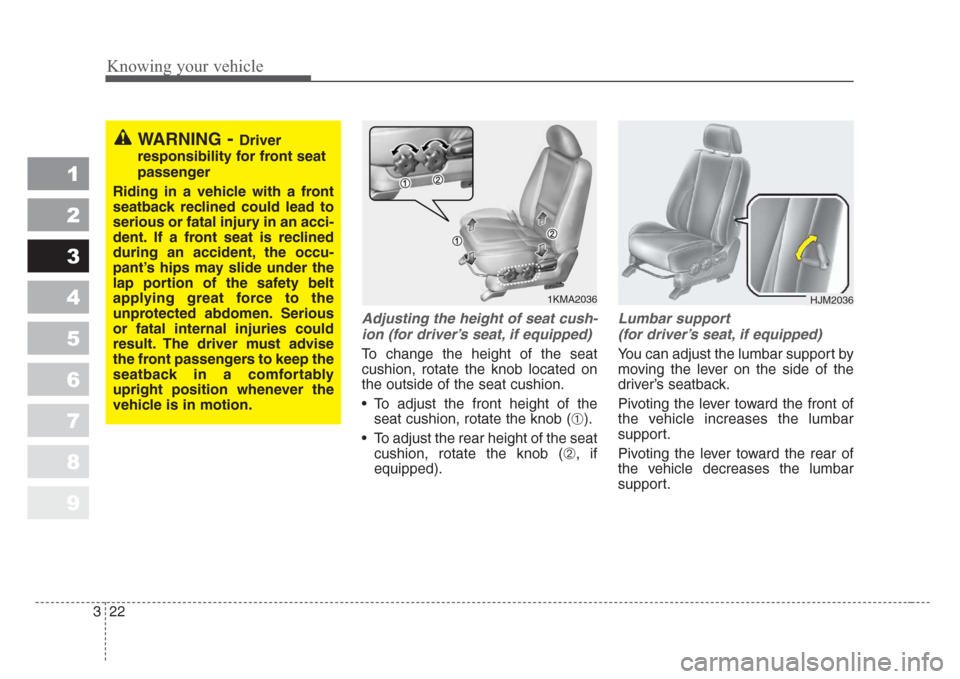
Knowing your vehicle
22 3
1
2
3
4
5
6
7
8
9
Adjusting the height of seat cush-
ion (for driver’s seat,if equipped)
To change the height of the seat
cushion, rotate the knob located on
the outside of the seat cushion.
• To adjust the front height of the
seat cushion, rotate the knob (
➀).
• To adjust the rear height of the seat
cushion, rotate the knob (
➁, if
equipped).
Lumbar support
(for driver’s seat,if equipped)
You can adjust the lumbar support by
moving the lever on the side of the
driver’s seatback.
Pivoting the lever toward the front of
the vehicle increases the lumbar
support.
Pivoting the lever toward the rear of
the vehicle decreases the lumbar
support.
WARNING-Driver
responsibility for front seat
passenger
Riding in a vehicle with a front
seatback reclined could lead to
serious or fatal injury in an acci-
dent.If a front seat is reclined
during an accident, the occu-
pant’s hips may slide under the
lap portion of the safety belt
applying great force to the
unprotected abdomen.Serious
or fatal internal injuries could
result.The dr
iver must advise
the front passengers to keep the
seatback in a comfortably
upright position whenever the
vehicle is in motion.
1KMA2036HJM2036
Page 33 of 350
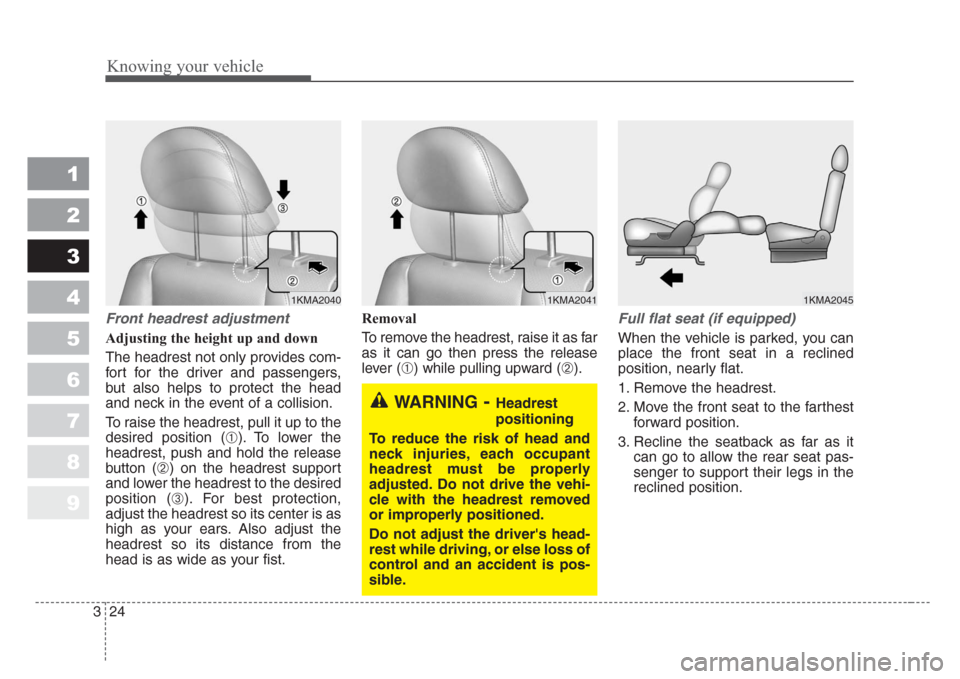
Knowing your vehicle
24 3
1
2
3
4
5
6
7
8
9
Front headrest adjustment
Adjusting the height up and down
The headrest not only provides com-
fort for the driver and passengers,
but also helps to protect the head
and neck in the event of a collision.
To raise the headrest, pull it up to the
desired position (
➀). To lower the
headrest, push and hold the release
button (
➁) on the headrest support
and lower the headrest to the desired
position (
➂). For best protection,
adjust the headrest so its center is as
high as your ears. Also adjust the
headrest so its distance from the
head is as wide as your fist.Removal
To remove the headrest, raise it as far
as it can go then press the release
lever (
➀) while pulling upward (➁).
Full flat seat (if equipped)
When the vehicle is parked, you can
place the front seat in a reclined
position, nearly flat.
1. Remove the headrest.
2. Move the front seat to the farthest
forward position.
3. Recline the seatback as far as it
can go to allow the rear seat pas-
senger to support their legs in the
reclined position.
1KMA2041
WARNING-Headrest
positioning
To reduce the risk of head and
neck injuries, each occupant
headrest must be properly
adjusted.Do not drive the vehi-
cle with the headrest removed
or improperly positioned.
Do not adjust the driver's head-
rest while driving, or else loss of
control and an accident is pos-
sible.
1KMA20451KMA2040
Page 38 of 350
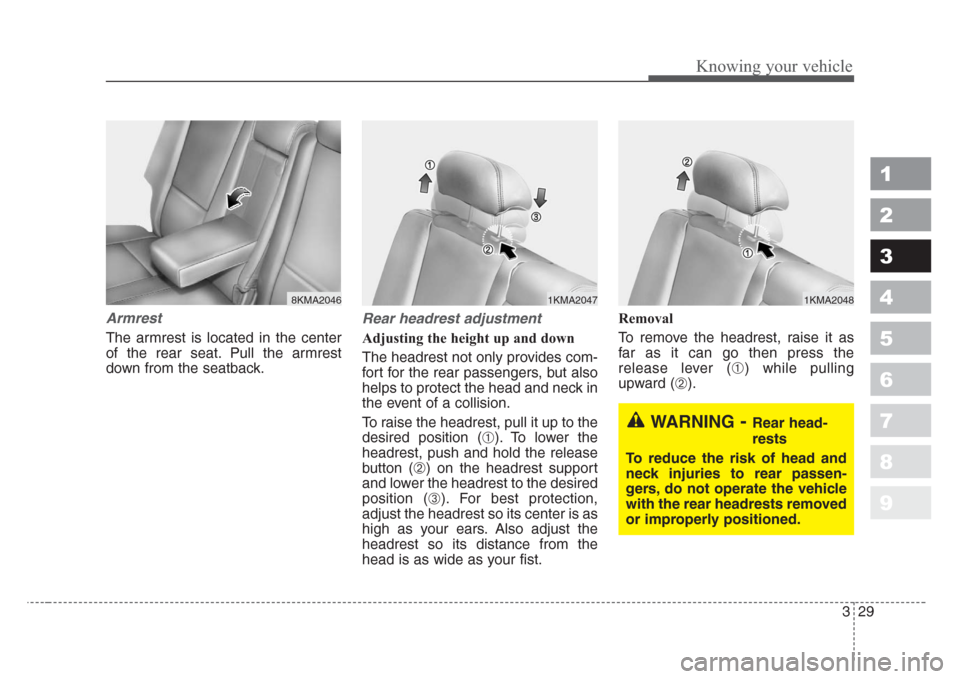
329
Knowing your vehicle
1
2
3
4
5
6
7
8
9
Armrest
The armrest is located in the center
of the rear seat. Pull the armrest
down from the seatback.
Rear headrest adjustment
Adjusting the height up and down
The headrest not only provides com-
fort for the rear passengers, but also
helps to protect the head and neck in
the event of a collision.
To raise the headrest, pull it up to the
desired position (
➀). To lower the
headrest, push and hold the release
button (
➁) on the headrest support
and lower the headrest to the desired
position (
➂). For best protection,
adjust the headrest so its center is as
high as your ears. Also adjust the
headrest so its distance from the
head is as wide as your fist.Removal
To remove the headrest, raise it as
far as it can go then press the
release lever (
➀) while pulling
upward (
➁).
8KMA20461KMA2047
WARNING-Rear head-
rests
To reduce the risk of head and
neck injuries to rear passen-
gers, do not operate the vehicle
with the rear headrests removed
or improperly positioned.
1KMA2048
Page 46 of 350
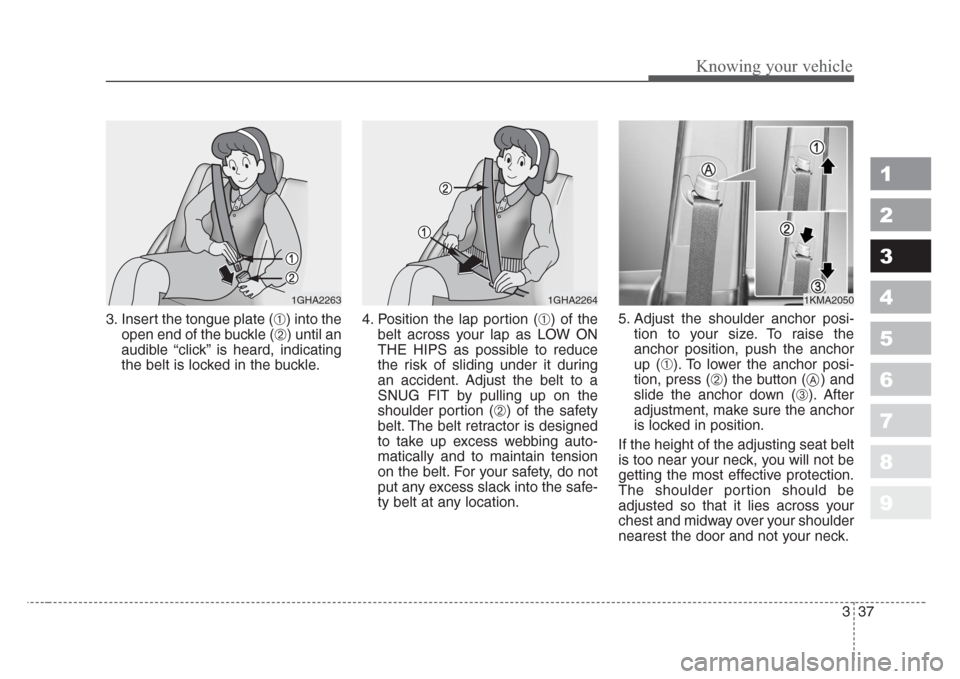
337
Knowing your vehicle
1
2
3
4
5
6
7
8
9
3. Insert the tongue plate (➀) into the
open end of the buckle (
➁) until an
audible “click” is heard, indicating
the belt is locked in the buckle.4. Position the lap portion (
➀) of the
belt across your lap as LOW ON
THE HIPS as possible to reduce
the risk of sliding under it during
an accident. Adjust the belt to a
SNUG FIT by pulling up on the
shoulder portion (
➁) of the safety
belt. The belt retractor is designed
to take up excess webbing auto-
matically and to maintain tension
on the belt. For your safety, do not
put any excess slack into the safe-
ty belt at any location.5. Adjust the shoulder anchor posi-
tion to your size. To raise the
anchor position, push the anchor
up (
➀). To lower the anchor posi-
tion, press (
➁) the button ( ) and
slide the anchor down (
➂). After
adjustment, make sure the anchor
is locked in position.
If the height of the adjusting seat belt
is too near your neck, you will not be
getting the most effective protection.
The shoulder portion should be
adjusted so that it lies across your
chest and midway over your shoulder
nearest the door and not your neck.
1GHA22631GHA22641KMA2050
A
Page 47 of 350
Knowing your vehicle
38 3
1
2
3
4
5
6
7
8
9
To unfasten the front lap/shoulder
belt:
Press the release button on the
buckle and allow the belt to slowly
retract.
Rear lap/shoulder belt
To f asten the rear lap/shoulder
belt:
1. Grasp the buckle and tongue
plate.
2. Slowly pull the lap/shoulder belt
out.
3. Insert the tongue plate (
➀) into the
open end of the buckle (
➁) until an
audible “click’’ is heard, indicating
the belt is locked in the buckle.
4GQB03381GHA2263
WARNING
• The height adjuster must be in
the locked position when the
vehicle is moving.
• The misadjustment of height
of the shoulder belt could
reduce the effectiveness of
the seat belt in a crash.
Page 90 of 350
381
1
2
3
4
5
6
7
8
9
Knowing your vehicle
Closing the hood
1. Before closing the hood, check the
following:
• All filler caps in engine compart-
ment must be correctly installed.
• Gloves, rags or any other com-
bustible material must be
removed from the engine com-
partment.
2. Secure the support rod in its clip.
3. Lower the hood to about 30 cm
(12 inches) height and then let it
drop to properly lock in place.
Make sure the hood is properly
locked before driving.
CAUTION - Hood
• Before closing the hood, make
sure that all engine parts and
tools have been removed from
the engine area and that no
one’s hands are near the hood
opening.
• Do not leave gloves,rags or
any other combustible materi-
al in the engine compartment.
Doing so may cause a heat-
induced fire.
Page 227 of 350
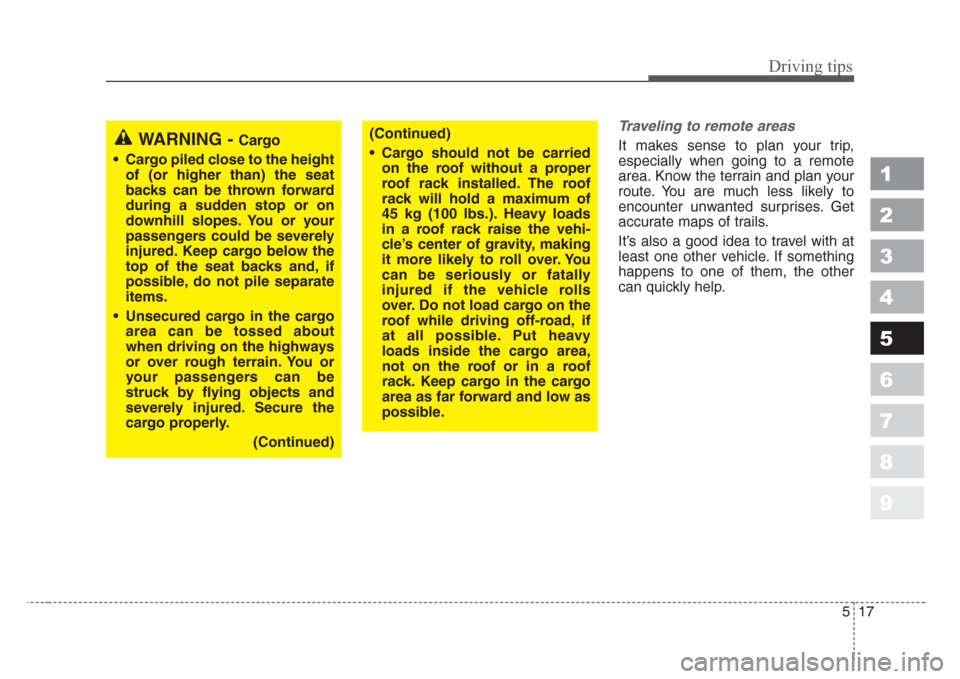
517
Driving tips
1
2
3
4
5
6
7
8
9
Traveling to remote areas
It makes sense to plan your trip,
especially when going to a remote
area. Know the terrain and plan your
route. You are much less likely to
encounter unwanted surprises. Get
accurate maps of trails.
It’s also a good idea to travel with at
least one other vehicle. If something
happens to one of them, the other
can quickly help.WARNING - Cargo
• Cargo piled close to the height
of (or higher than) the seat
backs can be thrown forward
during a sudden stop or on
downhill slopes.You or your
passengers could be severely
injured.Keep cargo below the
top of the seat backs and,if
possible, do not pile separate
items.
•Unsecured cargo in the cargo
area can be tossed about
when driving on the highways
or over rough terrain.You or
your passengers can be
struck by flying objects and
severely injured.
Secure the
cargo properly.
(Continued)
(Continued)
• Cargo should not be carried
on the roof without a proper
roof rack installed.The roof
rack will hold a maximum of
45 kg (100 lbs.).Heavy loads
in a roof rack raise the vehi-
cle’s center of gravity, making
it more likely to roll over.Yo u
can be seriously or fatally
injured if the vehicle rolls
over.Do not load cargo on the
roof while driving off-road,if
at all possible.Put heavy
loads inside the cargo area,
not on the roof or in a roof
rack.Keep cargo in the cargo
area as far forward and low as
po
ssible.